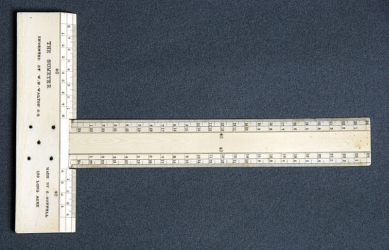Scientific Instrument Society 25th Anniversary Exhibition
Navigation:
<< First | < Previous | Next > | Last >>
15 The Sumeter
The ‘Sumeter’ – a combined ‘Chain and Offset scale’ – is a very unusual instrument based on the conventional chain scale and offset. The latter came in sets with scales ranging from 60 to 10 chains per inch and were made from boxwood or ivory. Chain and offset scales were probably in use from around 1840 and may have been introduced to replace the less practical non-read- to- edge ‘Equal Parts’ scales (a 6 inch version can be seen as part of my Harris Marquois set).
The name Sumeter is a conjoined word, sum + meter, where ‘sum’ may mean the solving of an arithmetical problem, and the old medieval word ‘meter’, meaning someone who measured – usually land, but it could be commodities. The Sumeter scale is graduated for 40 and in that respect is no different from any regular chain scale with 40 divisions to the inch. What makes this scale different is its T -shape with the offset riveted at right
angles to the scale.
The maker, Charles Suffell of 132 Long Acre, London was working at that address between 1839 -1865. ‘W. N. Walton C.E.’ must have invented the Sumeter scale within that period. My view is that Mr. Walton was a wily inventor who probably had no authority to put C.E. after his name, as the Institute of Civil Engineers have no record of his membership. When I saw this instrument for sale, it immediately attracted my attention as something very unusual.
See: Shorter Oxford English Dictionary 1972
G. Clifton, Directory of British Scientific Instrument Makers 1550 – 1851, 1996.
Collection: John Bateman, Yorkshire
Objects lent by John Bateman, Yorkshire:
14. Triangular Compass, English, Late 18th Century
16. Marquois Set, by William Harris, London, Early 19th Century

